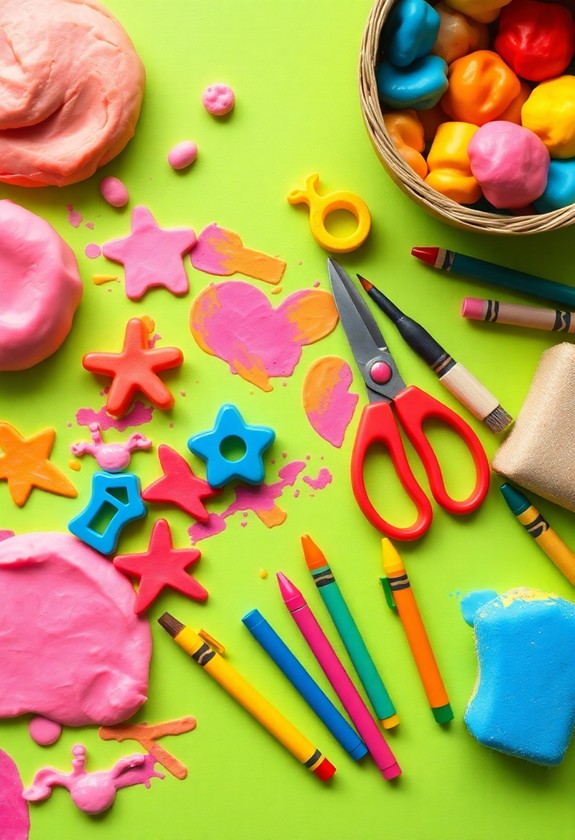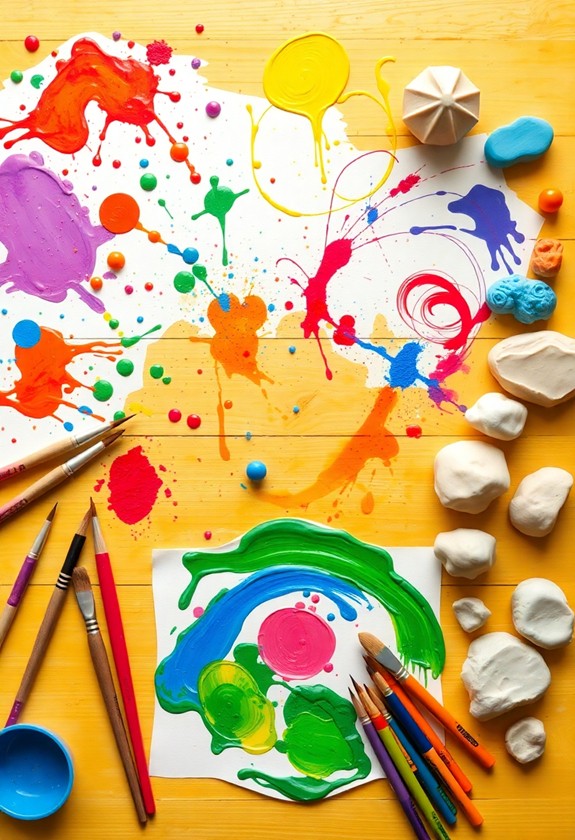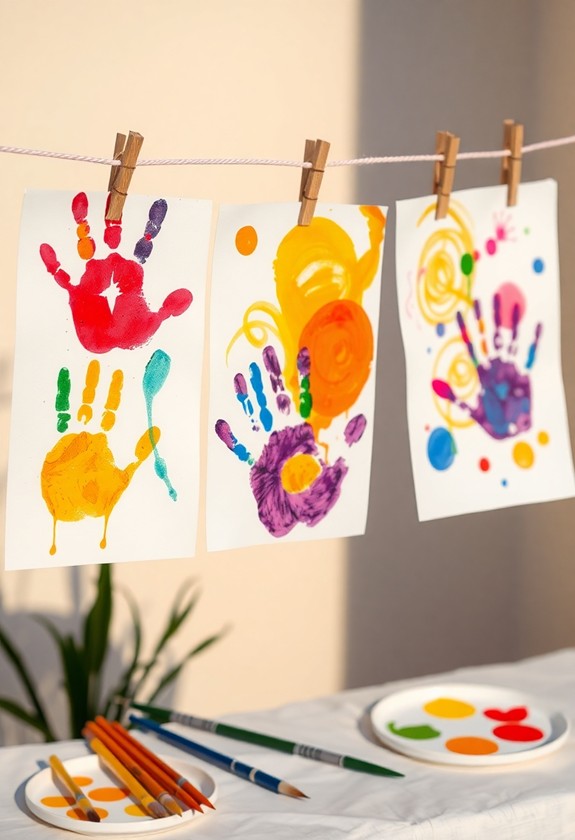Release your toddler's inner artist and enhance their fine motor skills with these five fantastic activities! Start with messy finger painting fun, then move on to squishy play dough sculpting. Next, try tearing and pasting colorful collages – it's a rip-roaring good time! Don't forget the classic scribbling with crayons, perfect for little hands. Finally, challenge those tiny fingers with stringing beads and pasta. Each activity is designed to boost coordination, creativity, and cognitive development. From splattering paint to threading noodles, your little one will have a blast as they master important skills. But wait, there's more to discover in the wonderful world of toddler art!
Creative Highlights
- Finger painting engages toddlers with colors and textures, fostering creativity and developing hand control.
- Play dough sculpting enhances fine motor skills through rolling, flattening, and imprinting activities.
- Tearing and pasting collages improve hand muscles and coordination while exploring textures and composition.
- Scribbling with crayons serves as a first drawing experience, enhancing grip and movement control.
- Stringing beads or pasta develops threading skills, promoting pattern creation and problem-solving abilities.
Finger Painting Fun
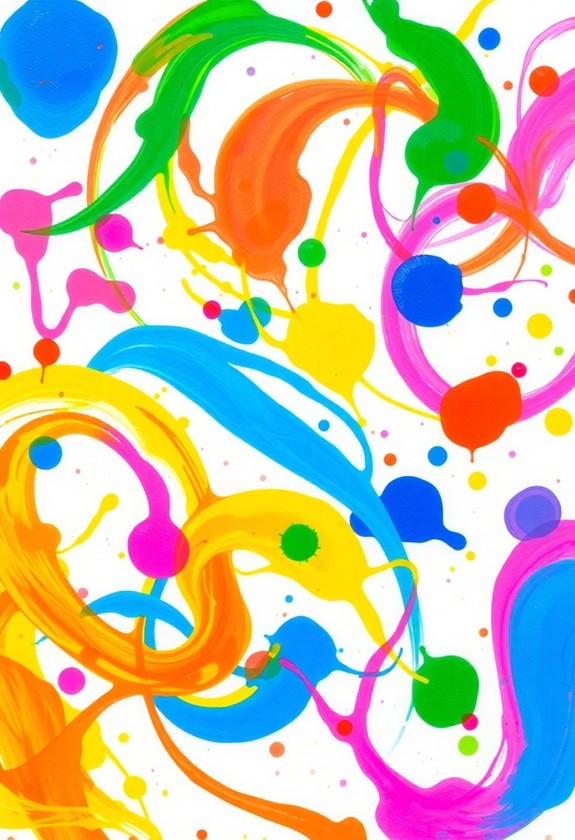
With a splash of color and a dash of imagination, finger painting is an excellent art activity for toddlers. It's time to get messy and have fun! This hands-on experience will have your little one giggling with glee as they investigate textures and create dynamic masterpieces. Non-toxic finger paints are crucial for safe artistic engagement, ensuring peace of mind for parents as they nurture creativity in their children.
Getting Started:
First, gather your supplies: washable finger paints, large sheets of paper, and a splash-proof surface. Don't forget to dress your toddler in old clothes – things are about to get colorful!
Let the Painting Begin:
Squirt small dollops of paint onto the paper and let your child jump in! Encourage them to use their fingers, palms, and even their toes to spread the paint. Watch as they uncover how colors mix and swirl together. It's like magic!
Tips and Tricks:
- Use scented paints for an extra sensory boost!
- Try painting on different surfaces like cardboard or bubble wrap.
- Make cleanup a breeze by finger painting in the bathtub.
Play Dough Sculpting
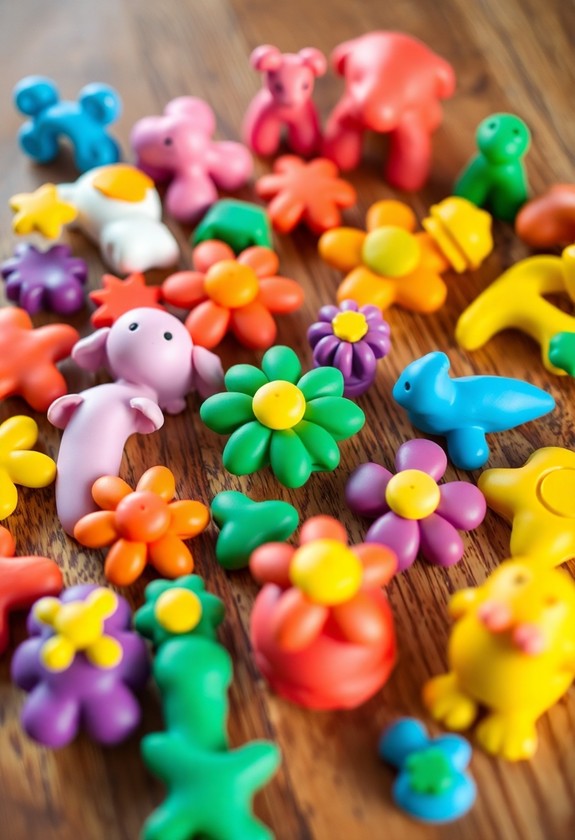
Moving from the world of wet paints to moldable materials, play dough sculpting offers another tactile adventure for toddlers. It's time to get hands-on with this squishy, pliable medium! Your little one will love squeezing, rolling, and shaping play dough into all sorts of fun creations. This activity not only improves fine motor skills but also supports cognitive development through creative thinking and sensory investigation.
Getting Started:
First, gather your supplies. You'll need play dough (store-bought or homemade), a clean surface, and some simple tools like plastic knives, cookie cutters, and rolling pins. Now, let the fun begin!
Sculpting Techniques:
Encourage your toddler to investigate different ways to mold the dough. They can:
- Roll it into snakes or balls
- Flatten it with their palms or a rolling pin
- Cut shapes with cookie cutters
- Press objects into it to make imprints
Creative Ideas:
Let their imagination run wild! They might create:
- A colorful garden of flowers
- A family of play dough people
- Their favorite animals
- A tasty-looking (but not edible!) play dough meal
Tearing and Pasting Collages
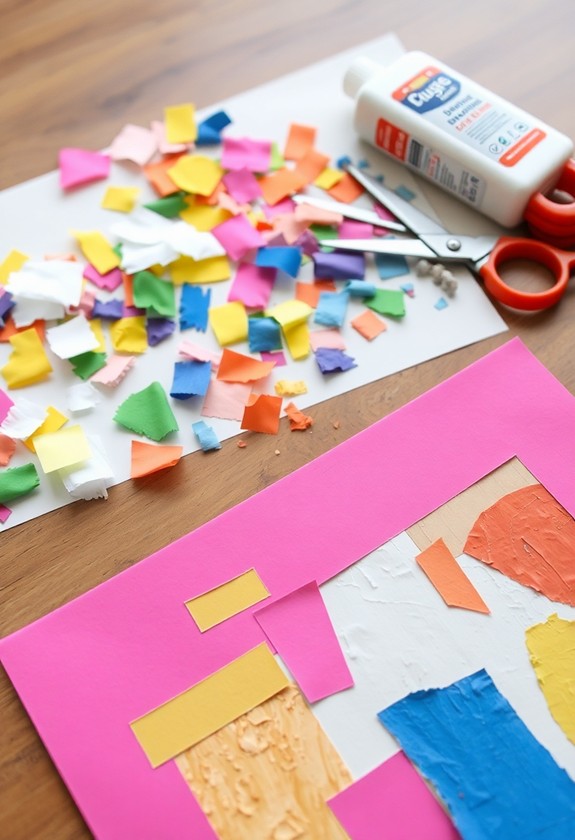
As play dough offers a moldable experience, tearing and pasting collages introduce toddlers to the world of textures and composition. It's time to release your little one's inner artist with this fun, tactile activity! This craft not only improves fine motor skills but also promotes cognitive development and creativity, making it an excellent choice for daycare settings.
Gather your materials: You'll need colorful paper, child-safe scissors, glue sticks, and a sturdy base (like cardstock). Don't forget to lay down some newspaper – things might get messy!
Let your toddler go wild with tearing! Ripping paper into small pieces helps develop those tiny hand muscles. It's a "tear-iffic" way to boost fine motor skills! Encourage them to investigate different textures – smooth magazine pages, crinkly tissue paper, or even fabric scraps.
Now for the sticky situation – pasting! Show your little one how to apply glue and stick the torn pieces onto the base. They'll love creating their very own masterpiece! And hey, who said art has to make sense? Let their imagination run free!
This activity isn't just fun – it's educational too. Your toddler will learn about colors, shapes, and spatial awareness. Plus, they'll develop hand-eye coordination and concentration. So, get ready for a "collage-tastic" time!
Scribbling With Crayons
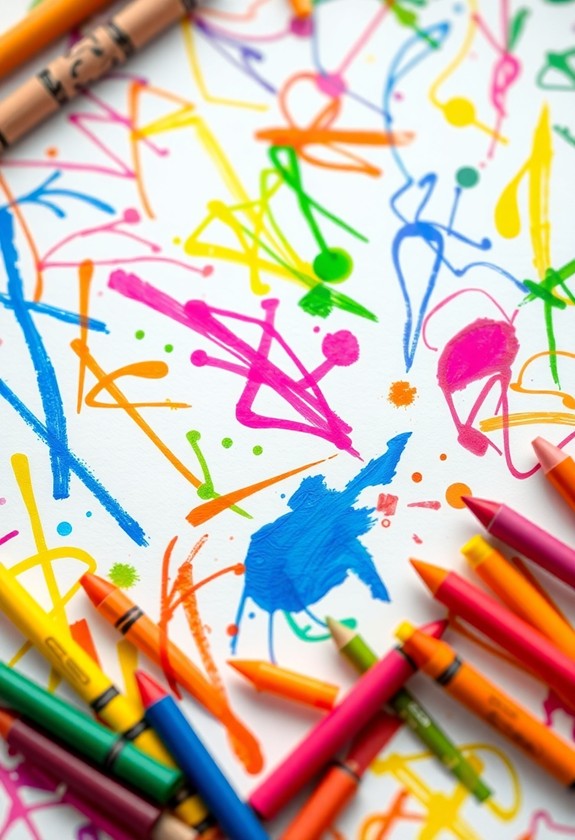
Scribbling with crayons is often a toddler's first foray into the world of drawing. It's an exciting milestone that you'll want to encourage! Start by offering your little one a variety of thick, chunky crayons that are easy for tiny hands to grasp. Don't forget to provide large sheets of paper or even a roll of butcher paper for endless scribbling fun! For a mess-free alternative, consider water reveal activity pages that allow toddlers to "color" using just water, perfect for on-the-go creativity without the worry of stains.
As your toddler scribbles away, you'll notice their grip improving and their movements becoming more controlled. This is great for developing those all-important fine motor skills! Encourage their efforts by praising their colorful creations and asking questions about their "masterpieces."
Want to add some pizzazz to their scribbling sessions? Try these crayon-tastic ideas:
- Color sorting: Offer crayons in specific colors and ask your tot to scribble with just those hues.
- Texture exploration: Let them scribble on different surfaces like cardboard or sandpaper.
- Crayon rubbings: Place objects under the paper and watch as patterns magically appear!
Stringing Beads and Pasta
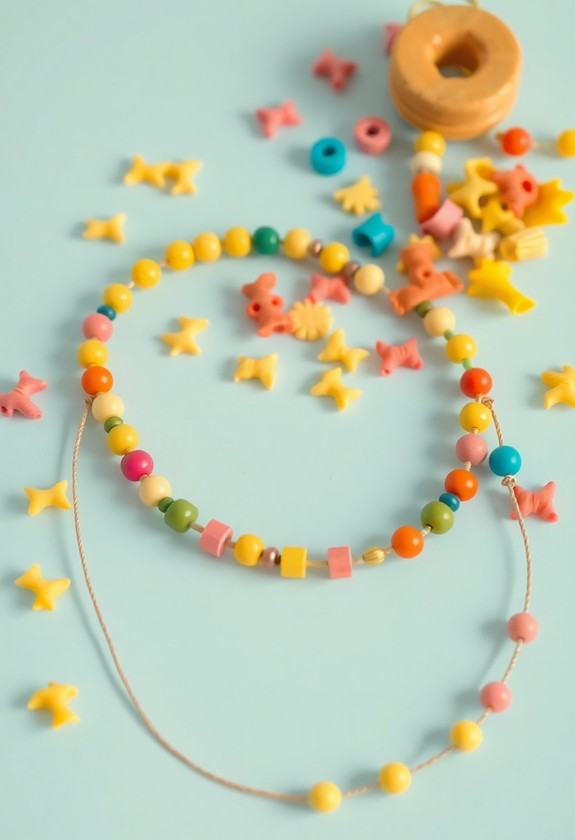
Once your toddler has mastered the art of scribbling, it's time to challenge their fine motor skills further with bead and pasta stringing. This fun activity will have your little one beaming with pride!
Getting started: Gather some large, colorful beads or tubular pasta and sturdy string or shoelaces. Ensure the holes are big enough for easy threading. Safety first: supervise your toddler closely to prevent choking hazards!
Now, let's get stringing! Show your toddler how to thread the beads or pasta onto the string. They'll love the satisfying "pop" as each piece slides into place. Encourage them to create patterns or tell a story with their choices. "Look, you've made a pasta-tively perfect necklace!" This activity not only develops fine motor skills but additionally enhances cognitive development through color recognition and pattern creation.
As they practice, you'll see their hand-eye coordination improve dramatically. They're developing patience, concentration, and problem-solving skills too! Don't worry if they struggle at first – it's all part of the learning process.
For added fun, try different shapes and sizes of beads or pasta. You can even paint the pasta for extra pizzazz! Before you know it, your little artist will be stringing up a storm and wearing their creations with pride.
Curious Little Questions
How Can I Make Art Activities Safe for Toddlers With Allergies?
Safety first, art lovers! For toddlers with allergies, you've got to be a super-sleuth! Check all materials for potential triggers. Go for hypoallergenic options like washable, non-toxic paints and clay. Avoid common allergens like wheat (in some Play-Doh) or dairy (in some paints). Keep the area well-ventilated, and always supervise. Don't forget to have fun! Try finger painting with safe foods like pudding or applesauce. It's a tasty masterpiece in the making! Remember, creativity knows no bounds!
What's the Best Way to Introduce Art Materials to Hesitant Toddlers?
Did you know that 85% of toddlers love getting messy? It's true! To introduce art materials to hesitant little ones, start small and make it fun. Begin with finger painting – it's a blast! Let them investigate textures and colors at their own pace. Try singing silly songs as you create, or turn it into a game. And remember, praise their efforts, not just the results. Before you know it, your tiny Picasso will be begging for more artsy adventures!
How Often Should Toddlers Engage in Art Activities for Optimal Development?
You'll want to make art a daily delight for your little one! Aim for at least 15-20 minutes of creative play every day. But don't sweat it if you miss a day – life happens! The key is consistency, not perfection. Mix it up with different materials and techniques to keep things exciting. Remember, toddlers have short attention spans, so multiple short sessions are better than one long one. Let their curiosity guide you, and watch their skills blossom like a colorful masterpiece!
Are There Any Art Activities That Can Help Left-Handed Toddlers Specifically?
Are you enthusiastic to help your little lefty paint the town red? Great news! There are plenty of art activities perfect for southpaw toddlers. Try these:
- Finger painting: It's messy but magical!
- Play-doh sculpting: Squish and squeeze to their heart's content
- Sticker art: Peeling and sticking builds dexterity
- Tearing paper: Rip it up for collages
And don't forget, lefty scissors are a game-changer! These activities will have your left-handed tot creating masterpieces in no time. Let the artistic adventures begin!
What Are Signs That a Toddler Might Be Gifted in Art?
You might have a mini Picasso on your hands! Look for these exciting signs: your toddler loves to draw and create for hours, shows amazing attention to detail, and experiments with different materials. They might likewise have a great memory for colors and shapes, and their artwork could be surprisingly advanced for their age. But remember, every child develops differently, so don't worry if you're not seeing these signs yet. Just keep encouraging their creativity!

